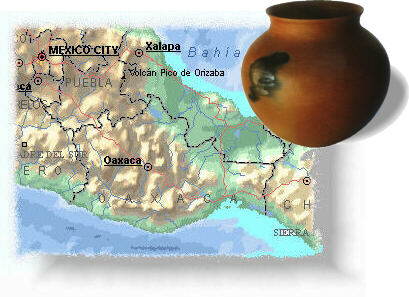 he place is
Oaxaca (wah-HA-ka), a wrinkled land of misted forest mountains and hot cactus valleys. The
potters are Zapotecs, Mixes (ME-hays), Mixtecs (ME-tex), and Triques (TREE-kays). Their
work is the humble creation of a jug for carrying water, a pot for cooking beans, a bowl
for storing corn. he place is
Oaxaca (wah-HA-ka), a wrinkled land of misted forest mountains and hot cactus valleys. The
potters are Zapotecs, Mixes (ME-hays), Mixtecs (ME-tex), and Triques (TREE-kays). Their
work is the humble creation of a jug for carrying water, a pot for cooking beans, a bowl
for storing corn. |
|
 |
 rom clay,
fire, and hands full of knowledge passed from mother to daughter in an unbroken lineage
that fades into the days of another age comes to life the pot. It is formed without a
wheel and shaped with simple tools: a piece of gourd, a strip of leather, and the deep
experience of patient time. It is warmed in the morning sun and fired in an open bonfire.
What emerges from the flame is the creation of simple perfection and grace, the work of
masters. rom clay,
fire, and hands full of knowledge passed from mother to daughter in an unbroken lineage
that fades into the days of another age comes to life the pot. It is formed without a
wheel and shaped with simple tools: a piece of gourd, a strip of leather, and the deep
experience of patient time. It is warmed in the morning sun and fired in an open bonfire.
What emerges from the flame is the creation of simple perfection and grace, the work of
masters. |
 n the waning
days of this century the pottery of Oaxaca is disappearing. Tin, plastic, and aluminum are
impatiently filling the place of clay. Today the potters still work, the pottery lives.
But the question arises, how many more mothers will be able to pass the ways of clay,
fire, and hands down to their daughters? n the waning
days of this century the pottery of Oaxaca is disappearing. Tin, plastic, and aluminum are
impatiently filling the place of clay. Today the potters still work, the pottery lives.
But the question arises, how many more mothers will be able to pass the ways of clay,
fire, and hands down to their daughters? |



 he place is
Oaxaca (wah-HA-ka), a wrinkled land of misted forest mountains and hot cactus valleys. The
potters are Zapotecs, Mixes (ME-hays), Mixtecs (ME-tex), and Triques (TREE-kays). Their
work is the humble creation of a jug for carrying water, a pot for cooking beans, a bowl
for storing corn.
he place is
Oaxaca (wah-HA-ka), a wrinkled land of misted forest mountains and hot cactus valleys. The
potters are Zapotecs, Mixes (ME-hays), Mixtecs (ME-tex), and Triques (TREE-kays). Their
work is the humble creation of a jug for carrying water, a pot for cooking beans, a bowl
for storing corn. 
 rom clay,
fire, and hands full of knowledge passed from mother to daughter in an unbroken lineage
that fades into the days of another age comes to life the pot. It is formed without a
wheel and shaped with simple tools: a piece of gourd, a strip of leather, and the deep
experience of patient time. It is warmed in the morning sun and fired in an open bonfire.
What emerges from the flame is the creation of simple perfection and grace, the work of
masters.
rom clay,
fire, and hands full of knowledge passed from mother to daughter in an unbroken lineage
that fades into the days of another age comes to life the pot. It is formed without a
wheel and shaped with simple tools: a piece of gourd, a strip of leather, and the deep
experience of patient time. It is warmed in the morning sun and fired in an open bonfire.
What emerges from the flame is the creation of simple perfection and grace, the work of
masters.  n the waning
days of this century the pottery of Oaxaca is disappearing. Tin, plastic, and aluminum are
impatiently filling the place of clay. Today the potters still work, the pottery lives.
But the question arises, how many more mothers will be able to pass the ways of clay,
fire, and hands down to their daughters?
n the waning
days of this century the pottery of Oaxaca is disappearing. Tin, plastic, and aluminum are
impatiently filling the place of clay. Today the potters still work, the pottery lives.
But the question arises, how many more mothers will be able to pass the ways of clay,
fire, and hands down to their daughters? 
